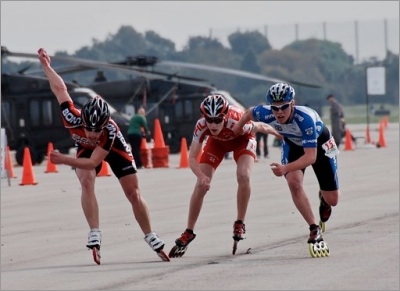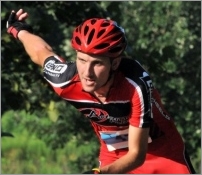 | ||
| ||||||||
By Ty Fidler At some point in our lives, we’ve all worked hard for something only to come up short. This happened to me in college. I would study long hours for upcoming exams only to be disappointed with my grades. Later, I figured out what went wrong. I didn’t know how to match my studying to individual exams. I was hitting the books for hours. But I wasn't preparing myself for the specific exam format (multiple choice, essay, fill in the blank). Once I started tailoring my preparation for each exam, my grades improved. This same thing applies to skate training. To be successful, you have to match your training to your goals. If you want to be a competitive racer, you can't simply train for distance. You also have to train for the other challenges of your race, like the field sprint, drafting, breakaways and hills. And that means you have to "study" for each of these challenges. Here’s how: 1) Train for sprints. Successful sprinters need strong technique and strength — and a little endurance. Use interval training to polish your sprint. And when you do this, imagine yourself in a race. Envision yourself breaking away from the back or launching a sprint a quarter-mile from the finish line. To prepare yourself for breakaways, work on fartleks — bursts of intense activity alternated with periods of less strenuous effort. To prepare for final sprints, do several 300-500 meter sprints at 100 percent effort one after another. Focus on staying low, maintaining your technique and going fast! And don’t be afraid to hit the weight room. Elite sprinters need lots of leg strength. You can build strength with squats and leg presses. 2) Build your endurance. Speed alone won’t get you to the podium in a road race. You’ll also need endurance. To build endurance, devote at least one day a week to a long skate of 20 miles or more at 75 percent effort. You can also build endurance with long-distance interval training. This training involves skating one- or two-mile intervals at about 90 percent effort. It’s hard work. But worth it. Alternately, jump on a road bike or go for a run — or anything else that will build your conditioning. 3) Polish your technique. Every year, I develop a deeper appreciation of the importance of technique. Bottom line: You can learn to go fast even if your technique is sloppy, but you’ll expend a lot more effort and need a lot more muscle. There are many ways to polish technique: you can attend skate clinics, study videos, skate behind good skaters, or practice drills. One of my favorite ways to work on technique is “slow skating," which is skating as slowly as possible with perfect form. When you slow skate, focus on shifting your weight over your support leg, keeping your nose, knees, and toes aligned, pushing to the side, sitting low, and proper arm swing. Work on technique every time you skate. You can do this by simply devoting the first 15 minutes of your skate to technique or you can give it the whole day. Whatever you put into technical training will pay dividends. 4) Prepare for the worst. Take advantage of bad weather to prepare yourself for foul-weather races. It’s not as fun to skate in the cold or with a stiff headwind. But it prepares you mentally for what you may face at your next race. Along the same lines, seek out bad pavement once in a while. Few outdoor races have uniformly smooth pavement. But you can skate just about anything with practice. 5) Master hills. Almost every race course has some sort of hills. And, as any experienced racer will tell you, those hills are often the defining factor in a race. During races, surges often happen on steep climbs. The skaters who attack on hills do serious damage to their competitors; and more often than not, they win the race. Eddy Matzger’s victory in the New York 100K in 2010 is a perfect example. Eddy’s ability to climb hills helped him roll away from a world class field.
The secret to skating hills is practice. Seek them out and skate them as part of your training. And don’t just skate them: attack them. And practice going down hills, too. You build up speed fast when you roll downhill. And that can be scary if you’re not used to it. Once again, the key is to match your training to what you are likely to experience in a race. Even if you are not a racer, always focus your workouts on quality rather than quantity. Quality training gets you where you want to go. Unfocused "quantity training" doesn't guarantee anything and usually ends with low grades. ---
Related reading: • Skate Tip of the Week Archive
...
Copyright © 2011 Inline Planet | ||||||||



